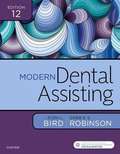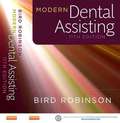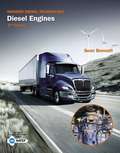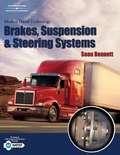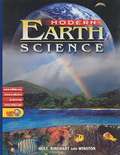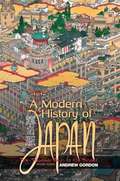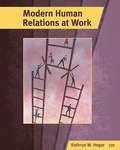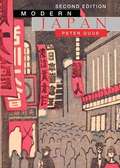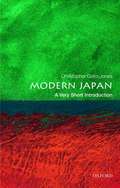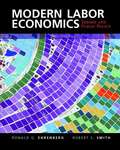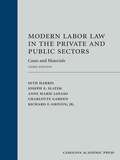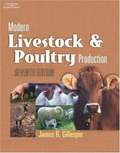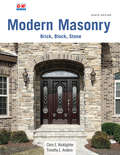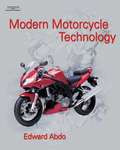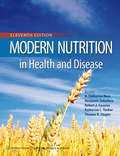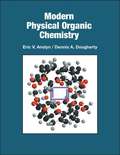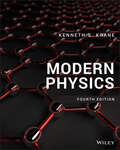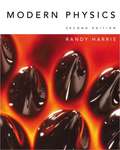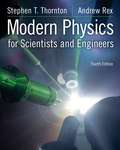- Table View
- List View
Modern Dental Assisting
by Doni L. Bird; Debbie S. RobinsonThe 12th edition showcases a brand-new illustration program and content on technological advances, public health and access to care, tele dentistry, infection control guidelines, the Zika virus, Ebola, the oral-systemic health connection, and much more. <P><P>Written by trusted experts Doni Bird and Debbie Robinson, this is the all-in-one learning resource you need to stay ahead of the curve in the modern world of dental assisting.
Modern Dental Assisting (11th Edition)
by Doni L. Bird Debbie S. RobinsonPrepare for a successful career as a dental assistant with Modern Dental Assisting, 11th Edition! Using an easy-to-understand approach, this book provides a complete foundation in the basic and advanced skills you must master to achieve clinical competence.
Modern Diesel Technology: Diesel Engines (Second Edition)
by Sean BennettMODERN DIESEL TECHNOLOGY: DIESEL ENGINES, Second Edition, provides a thorough, reader-friendly introduction to diesel engine theory, construction, operation, and service. Combining a simple, straightforward writing style, ample illustrations, and step-by-step instruction, this trusted guide helps aspiring technicians develop the knowledge and skills they need to service modern, computer-controlled diesel engines. The book provides an overview of essential topics such as shop safety, tools and equipment, engine construction and operation, major engine systems, and general service and repair concepts. Dedicated chapters then explore engine, fuel, and vehicle computer control subsystems, as well as diesel emissions. Thoroughly revised to reflect the latest technology, trends, and techniques--including current ASE Education Foundation standards--the Second Edition provides an accurate, up-to-date introduction to modern diesel engines and a solid foundation for professional success.
Modern Diesel Technology: Brakes, Suspension, and Steering
by Sean BennettBeginning with entry-level explanations of the critical systems and advancing to the standard required of ASE L4 and L5 certification testing, this stand-alone book is a first-rate primer in the study of highway truck and trailer brake, suspension, and steering systems. Modular in format, the book's chapters cover basic principles directed to specific, performance-based learning outcomes. Step-by-step photo sequences for many critical shop-based tasks and an emphasis on troubleshooting help learners make the connection between conceptual and hands-on learning.
Modern Earth Science
by Robert J. Sager William L. Ramsey Clifford R. Phillips Frank M. WatenpaughStudying the earth is like putting together a complex jigsaw puzzle that is made up of pieces that are constantly changing shape. As time passes, many of the pieces change so much they don't even resemble their original shape.
Modern Earth Science
by Robert J. Sager William L. Ramsey Clifford R. Phillips Frank M. WatenpaughStudying the earth is like putting together a complex jigsaw puzzle that is made up of pieces that are constantly changing shape. As time passes, many of the pieces change so much they don't even resemble their original shape.
The Modern Historiography Reader: Western Sources (Routledge Readers in History)
by Adam Budd<p>In The Modern Historiography Reader, Adam Budd guides readers through European and North American developments in history-writing since the eighteenth century. Starting with Enlightenment history and moving through subjects such as moral history, national history, the emergence of history as a profession, and the impact of scientific principles on history, he then looks at some of the most important developments in twentieth-century historiography such as social history, traumatic memory, postcolonialism, gender history, postmodernism, and the history of material objects. <p>This is the only book that brings together historiographical writing from anthropology, literary theory, philosophy, psychology, and sociology – as well as history. Each of the thirteen thematic sections begins with a clear introduction that familiarizes readers with the topics and articles, setting them in their wider contexts. They explain what historiography is, how historians’ perspectives and sources determine the kinds of questions they ask, and discuss how social and ideological developments have shaped historical writing over the past three centuries. <p>With a glossary of critical terms and reading lists for each section, The Modern Historiography Reader: Western Sources is the perfect introduction to modern historiography.</p>
Modern History OF India - Competitive Exam
by Indic TrustThis is a compilation of questions answer of Mordern History of India For Civil Services Competitive Examinations.
A Modern History of Japan: From Tokugawa Times to the Present (2nd edition)
by Andrew GordonGordon (history and Japanese studies, Harvard U.) begins his history in about 1800, looking at how particularly the industrial revolution had changed the balance of global economic and military power, and the pressures that caused the Tokugawa military lords to fall from power. Annotation (c)2003 Book News, Inc., Portland, OR (booknews.com)
Modern Human Relations at Work (11th Edition)
by Kathryn W. HegarThis book includes many practical examples and techniques, as well as experiential and application-oriented exercises that show you how human relations concepts and skills can increase productivity and job satisfaction in the workplace. The 11th edition's 14 chapters are brimming with self-assessment and self-study tools that make learning fun, insightful, and useful.
Modern Japan
by Peter DuusJapan's rise to world prominence --first as an aggressively westernizing Asian nation, then as a major imperialist power, and finally its resurgence as a postwar economic giant. The text has been completely revised to reflect recent events including Japan's role in WWII, women's history, and Japan's rise to become a leading economic power. The text is 1) The Fall of the Tokugawa On 2) The Pursuit of Wealth and Power, 1868-1905 3) Political Change, Crisis, and War, 1905-1945 4) Peace, Prosperity, and Stability
Modern Japan: A Very Short Introduction
by Christopher Goto-JonesJapan is arguably today's most successful industrial economy, combining almost unprecedented affluence with social stability and apparent harmony. Japanese goods and cultural products--from animated movies and computer games to cars, semiconductors, and management techniques--are consumed around the world. In many ways, Japan is an icon of the modern world, and yet it remains something of an enigma to many, who see it as a confusing montage of the alien and the familiar, the ancient and modern. This Very Short Introduction explodes the myths and explores the reality of modern Japan, offering a concise, engaging, and accessible look at the history, economy, politics, and culture of this fascinating nation. It examines what the term "modern" means to the Japanese, debunks the notion that Japan went through a period of total isolation from the world, and explores the continuity between pre- and post-war Japan. Anyone curious about this intriguing country will find a wealth of insight and information in these pages.
Modern Labor Economics: Theory and Public Policy
by Ronald G. Ehrenberg Robert S. SmithDesigned for students who may not have extensive backgrounds in economics, the text balances theoretical coverage with examples of practical applications that allow students to see concepts in action.
Modern Labor Law in the Private and Public Sectors: Cases and Materials
by Seth D. Harris Joseph E. Slater Anne Marie Lofaso Charlotte Garden Richard F. Griffin Jr.This casebook adopts a truly modern approach to labor law in the United States, introducing students to the subject as it is practiced today. It is built around two important trends: the shift of union density from the private sector to the public sector and the growth of organizing outside the NLRA process. <p><p>The third edition adds a new coauthor: Richard F. Griffin, Jr., who served as the NLRB’s General Counsel under President Obama. It also includes the numerous changes in private-sector labor law made by the NLRB under President Trump, Janus v. AFSCME, and more.
Modern Literature, MA English Previous Paper III, SDE Andhra University
by Prof T Padma Prof Ila Rao Prof MS Rama Murthy Prof AVV Narasimha Swamy Prof P Sowmini Prof Vc Sudheer Prof L Manjula Davidson Mv Raja Kumar Prof. Mrs. K. Lakshmi DeviThis is the prescribed text book for Modern Literature, MA English Previous papger III for the students of School of Distance Education, Andhra University
Modern Livestock & Poultry Production
by James R. GillespieThis text for vocational-technical students emphasizes readability, organization, and hands-on activities. Sections cover the livestock industry, feeding and nutrition, animal breeding, and the production of various stock including beef cattle, poultry, llamas, and bison. This seventh edition adds information on anatomy and physiology and on appropriate work habits, and includes student learning activities. Gillespie is a retired teacher of agricultural education. Annotation (c)2003 Book News, Inc. , Portland, OR (booknews. com)
Modern Livestock & Poultry Production
by James R. GillespieModern Livestock and Poultry Production, seventh edition is the textbook students and instructors turn to for thorough coverage of the animal agriculture industry. For each of the many species discussed in the text, students will find essential information about the breeds, selection of breeding stock, feeding and species management, diseases and parasites common to the species and marketing. Material is derived from the latest research and most current information about animal genetics, breeding, nutrition, biotechnology and product promotion. The text provides complete coverage of such major farm animal enterprises as beef cattle, swine, sheep, goats, horses, poultry and dairy cattle. Minor animal enterprises addressed include rabbits, bison, ratites, llamas and alpacas. Students will gain a comprehensive understanding of the livestock industry, including career opportunities.
Modern Masonry
by Clois E. Kicklighter and Timothy L. AnderaModern Masonry: Brick, Block, Stone provides a broad understanding of the properties and applications of masonry materials. It begins with coverage on careers to help students learn about the industry. It then progresses to teaching safe and proper procedures for working with brick, block, and stone. Coverage of concrete form construction and flatwork is also included. Green features address specific topics relating to masonry’s impact on the environment.
The Modern Middle East: A Political History Since the First World War
by Mehran KamravaThe first succinct and authoritative overview of the making of the modern Middle East, this lucid book brings a valuable mix of historical perspectives and contemporary analysis to a wide audience of readers seeking expert knowledge about this troubled and fascinating region. Giving a rich perspective on the region's historical and political evolution, the book traces the influence of factors such as religion, culture, and economics and illuminates events and topics currently in the news. With its broad thematic sweep and its balanced presentation of contentious issues, it is essential reading for general readers and students who want to better understand the world today. Mehran Kamrava sets the stage with a concise discussion of the evolution of Islam and the religion's profound role in the region. He then looks at, in turn, the rise and fall of the Ottomans, the trials of independence and state-building, the emergence and fiery spread of nationalism, the two Arab-Israeli wars of 1967 and 1973, the Iranian Revolution, and the two Gulf Wars and beyond, including discussion of the invasion of Iraq by the United States. After tracing the consequences of these historical events for a host of political phenomena, Kamrava gives detailed attention to three pivotal issues: the challenges of economic development, the Palestinian-Israeli conflict, and the question of democracy. He also examines issues that will shape the future: population growth, environmental pollution, and water scarcity.
Modern Motorcycle Technology
by Edward AbdoWith the most up-to-date information on today's motorcycles, Modern Motorcycle Technology takes readers on an in-depth exploration of the internal and external workings of motorcycles. The book begins with an overview of motorcycle technology, from a history of the vehicle to the current state of the industry. Coverage then progresses to include safety measures, engine operation, internal combustion engines, electrical fundamentals, and overall motorcycle maintenance. With a special chapter devoted to troubleshooting and a straightforward writing style for better comprehension, this book is a valuable resource for anyone seeking the knowledge and skills needed to succeed in today's motorcycle technology field.
Modern Nutrition in Health and Disease (11th Edition)
by A. Catharine Ross Benjamin Caballero Robert J. Cousins Katherine L. Tucker Thomas R. ZieglerThis book offers complete, authoritative reference on nutrition and its role in contemporary medicine, dietetics, nursing, public health, and public policy.
Modern Physics
by Kenneth S. KraneOne of the field’s most respected introductory texts, Modern Physics provides a deep exploration of fundamental theory and experimentation. Appropriate for second-year undergraduate science and engineering students, this esteemed text presents a comprehensive introduction to the concepts and methods that form the basis of modern physics, including examinations of relativity, quantum physics, statistical physics, nuclear physics, high energy physics, astrophysics, and cosmology. A balanced pedagogical approach examines major concepts first from a historical perspective, then through a modern lens using relevant experimental evidence and discussion of recent developments in the field. The emphasis on the interrelationship of principles and methods provides continuity, creating an accessible “storyline” for students to follow.
Modern Physics (2nd Edition)
by Randy HarrisModern Physics, Second Edition provides a clear, precise, and contemporary introduction to the theory, experiment, and applications of modern physics. This eagerly awaited second edition puts the modern back into modern physics courses. Pedagogical features throughout the text focus the reader on the core concepts and theories while offering optional, more advanced sections, examples, and cutting-edge applications to suit a variety of courses. Critically acclaimed for his lucid style, in the second edition, Randy Harris applies the same insights into recent developments in physics, engineering, and technology. Physics at the Turn of the 20th Century, Special Relativity, Waves and Particles I: Electromagnetic Radiation Behaving as Particles, Waves and Particles II: Matter Behaving as Waves, Bound States: Simple Cases, Unbound States: Obstacles, Tunneling and Particle-Wave Propagation, Quantum Mechanics in Three Dimensions and The Hydrogen Atom, Spin and Atomic Physics, Statistical Mechanics, Bonding: Molecules and Solids, Nuclear Physics, Fundamental Particles and Interactions. For all readers interested in modern physics.
